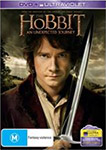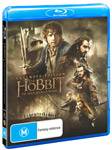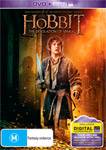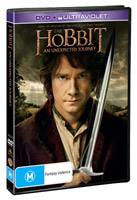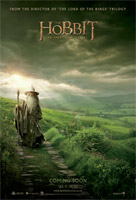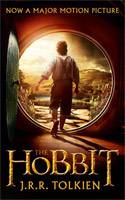Peter Jackson The Hobbit: The Battle of the Five Armies
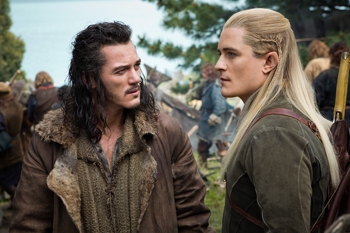
Peter Jackson The Hobbit: The Battle of the Five Armies
Cast: Lee Pace, Benedict Cumberbatch, Richard Armitage
Director: Peter Jackson
Genre: Adventure, Fantasy
Synopsis: From Academy Award-winning filmmaker Peter Jackson comes 'The Hobbit: The Battle of the Five Armies," the third in a trilogy of films adapting the enduringly popular masterpiece The Hobbit, by J.R.R. Tolkien.
'The Hobbit: The Battle of the Five Armies" brings to an epic conclusion the adventures of Bilbo Baggins (Martin Freeman), Thorin Oakenshield (Richard Armitage) and the Company of Dwarves. The Dwarves of Erebor have reclaimed the vast wealth of their homeland, but now must face the consequences of having unleashed the terrifying Dragon, Smaug, upon the defenseless men, women and children of Lake-town.
As he succumbs to dragon-sickness, the King Under the Mountain, Thorin Oakenshield, sacrifices friendship and honor in his search for the legendary Arkenstone. Unable to help Thorin see reason, Bilbo is driven to make a desperate and dangerous choice, not knowing that even greater perils lie ahead. An ancient enemy has returned to Middle-earth. Sauron, the Dark Lord, has sent forth legions of Orcs in a stealth attack upon the Lonely Mountain. As darkness converges on their escalating conflict, the races of Dwarves, Elves and Men must decide"unite or be destroyed. Bilbo finds himself fighting for his life and the lives of his friends as five great armies go to war.
'The Hobbit" Trilogy tells a continuous story set in Middle-earth 60 years before 'The Lord of the Rings," which Academy Award-winning filmmaker Peter Jackson and his team brought to the big screen in the blockbuster trilogy that culminated with the Oscar-winning 'The Lord of the Rings: The Return of the King." Ian McKellen returns as Gandalf the Grey, with Martin Freeman in the central role of Bilbo Baggins, and Richard Armitage as Thorin Oakenshield. The international ensemble cast is led by Evangeline Lilly, Luke Evans, Lee Pace, Benedict Cumberbatch, Billy Connolly, James Nesbitt, Ken Stott, Aidan Turner, Dean O'Gorman, Graham McTavish, Stephen Fry, and Ryan Gage. The film also stars Cate Blanchett, Ian Holm, Christopher Lee, Hugo Weaving, Orlando Bloom, Mikael Persbrandt, Sylvester McCoy, Peter Hambleton, John Callen, Mark Hadlow, Jed Brophy, William Kircher, Stephen Hunter, Adam Brown, John Bell, Manu Bennett and John Tui.
The screenplay for 'The Hobbit: The Battle of the Five Armies" is by Fran Walsh & Philippa Boyens & Peter Jackson & Guillermo del Toro, based on the novel by J.R.R. Tolkien. Jackson also produced the film, together with Carolynne Cunningham, Zane Weiner and Fran Walsh. The executive producers are Alan Horn, Toby Emmerich, Ken Kamins and Carolyn Blackwood, with Philippa Boyens and Eileen Moran serving as co-producers.
The creative behind-the-scenes team is led by director of photography Andrew Lesnie, production designer Dan Hennah, editor Jabez Olssen and composer Howard Shore. The costumes are designed by Richard Taylor, Bob Buck and Ann Maskrey. Taylor is also overseeing the design and production of armour, weapons, creatures and special makeup, which are once again being made by the award-winning Weta Workshop. Oscar-winning visual effects studio Weta Digital is again handling the visual effects for the film, led by senior visual effects supervisor Joe Letteri. The hair and makeup designer is Peter Swords King. The conceptual designers are John Howe and Alan Lee. Eric Saindon is the visual effects supervisor, with David Clayton serving as animation supervisor.
Under Jackson's direction, 'The Hobbit: The Battle of the Five Armies" was shot in 3D 48 frames-per-second and will be released in High Frame Rate 3D (HFR 3D) in select theaters, other 2D and 3D formats, and IMAX®. Production took place at Jackson's own facilities in Miramar, Wellington, and on location around New Zealand. Post production took place at Park Road Post Production in Wellington.
The Hobbit: The Battle of the Five Armies
Release Date: December 26th, 2014
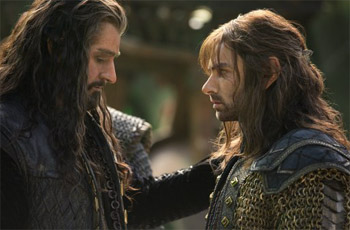 About The Production
About The Production
'Will you fight with me one last time?" "Thorin Oakenshield
'The Hobbit: The Battle of the Five Armies" represents the culmination of director/co-writer/producer Peter Jackson's 16-year journey to bring to life the richly layered universe of Middle-earth conjured nearly a century ago by J.R.R. Tolkien in his literary masterworks The Hobbit and The Lord of the Rings. The Hobbit, or There and Back Again was first published in 1937, having emerged from the revered author, poet, university professor and philologist's imagination as bedtime stories for his children. In the 17 years that followed, J.R.R. Tolkien continued to develop, expand and enrich the complex mythology of Middle-earth to produce its sprawling, apocalyptic conclusion, The Lord of the Rings. Collectively, the author's towering modern myth has had a seismic impact on world culture, becoming among the best-selling novels ever written, and sparking the imaginations of generations of readers all over the world.
Among them was a teenaged Peter Jackson, who took his first dive into Middle-earth while traveling by train across his native New Zealand"but it wouldn't be his last. As early as 1995, the filmmaker explored the idea of adapting The Hobbit for the screen, hoping to then move on to adapt The Lord of the Rings. Instead, Peter Jackson ultimately reversed the journey that J.R.R. Tolkien himself had taken"telling the end of the story first with his landmark, Oscar-winning 'The Lord of the Rings" Trilogy, then plunging back into the fully realised world he'd created to bring the mythology's seminal origins to life with the same vast scale, technical mastery and emotional resonance in 'The Hobbit" Trilogy.
To embody the iconic roles introduced in this earlier tale, the filmmakers assembled a core of gifted actors, including Martin Freeman as the Hobbit Bilbo Baggins, Richard Armitage as the Dwarf Lord Thorin Oakenshield, Luke Evans as Bard the Bowman, Evangeline Lilly as Silvan Elf Warrior Tauriel, Lee Pace as Elvenking Thranduil of the Woodland Realm, Billy Connolly as Dwarf General Dain Ironfoot of the Iron Hills, and Benedict Cumberbatch breathing life into the Trilogy's iconic villains, the Dragon Smaug and the Dark Lord Sauron.
The new trilogy would also reunite the director with members of the celebrated cast of 'The Lord of the Rings" films nearly a decade after their release, including Ian McKellen as the Wizard Gandalf the Grey; Cate Blanchett, Hugo Weaving and Orlando Bloom as High Elves Galadriel, Elrond and Legolas, respectively; Christopher Lee as the Wizard Saruman the White; Ian Holm reprising his role as the older Bilbo Baggins; and Andy Serkis returning to his memorable incarnation of Gollum in the first film, 'The Hobbit: An Unexpected Journey," as well as serving as second unit director for the entire Trilogy.
Together, Peter Jackson, his close band of filmmaking collaborators and international ensemble cast embarked on a new adventure"plunging into a nine-month-long filmmaking journey across New Zealand to simultaneously create all three films, releasing the first film, 'The Hobbit: An Unexpected Journey," in 2012, and following a year later with 'The Hobbit: The Desolation of Smaug." This compelling cinematic journey now reaches its epic conclusion with the release of the third and final film, 'The Hobbit: The Battle of the Five Armies."
As Peter Jackson prepares to sweep audiences back to Middle-earth one last time, he reflects that throughout his epic filmmaking odyssey through Middle-earth, his true north has always remained his passion for the artistic legacy of J.R.R. Tolkien and his own desire to see it brought to vibrant, visceral life on the big screen.
'When we made -The Lord of the Rings' films, there was a lot of pressure because it was a big project done in a way that was unprecedented, and we didn't have the track record then that we have now," says the Oscar-winning filmmaker. 'Those films went out into the world, and have now become part of the culture, so that created a different kind of pressure on -The Hobbit' movies. But the only way you can respond to that is to be truthful to yourself as a filmmaker. With everything I've done in my career, I've tried to make films that I would enjoy as a moviegoer. To see the first two -Hobbit' films be embraced by fans has been a joy, because we're fans as well. But it's also exciting to introduce a new generation to this world and this incredible mythology for the first time with the story where it all begins."
As with all three films in 'The Hobbit" Trilogy, Peter Jackson crafted the screenplay for 'The Hobbit: The Battle of the Five Armies" with his longtime collaborators Fran Walsh and Philippa Boyens, along with Guillermo del Toro. Philippa Boyens, who is also a co-producer of the Trilogy, observes that, for the collaborators, it felt as if 'The Lord of the Rings" films were meant to be made first before turning back the clock to complete the tale. 'In many ways, -The Hobbit' films are better for us having gone through that experience and established this incredible cast," she says. 'It also gave us the broader canvas against which -The Hobbit' films truly unfold, and a deeper understanding of how this little adventure leads directly into that vast, world-changing mythology that informs -The Lord of the Rings' films."
The tale of the Hobbit Bilbo Baggins, who embarks on a wondrous and dangerous adventure in the Wild with the Wizard Gandalf and the Company of Dwarves, grew in the telling to birth the resonant themes that are woven throughout the J.R.R. Tolkien canon"the bonds of friendship, the nature of honor and sacrifice, the corruption of wealth and power, and the quiet courage of the unlikeliest of heroes, which may hold even the greatest forces of evil at bay.
But, for J.R.R. Tolkien himself, the novel as published did not tell the whole story. Within 125 pages of notes included in the final book of The Lord of the Rings, the author mapped out in detail the forces of darkness and light at work in Middle-earth at the time of The Hobbit, which provides vital connective tissue between Bilbo's adventure and the legacy his nephew, Frodo Baggins, will ultimately inherit. 'Professor Tolkien left us a gift in this addendum to The Lord of the Rings," says Fran Walsh, who is also among the Trilogy's producers. 'It came from his need to grow this world and tell more of the story, which gave us an organic way to expand the tale through all three films, while honoring what Professor J.R.R. Tolkien intended."
The untold stories in the appendices also provided Peter Jackson with a rich palette that would enable him to begin 'The Hobbit" Trilogy with the brighter, more innocent tone of the novel and gradually move into a darker emotional climate as the adventure gives way to all-out war. 'The epic battle at the center of this film is the climax of three movies' worth of storylines, which all continue to play out even as armies are clashing on the battlefield," Peter ackson says. 'There is a lot of suspense and tension, triumph as well as tragedy, as the various agendas and personal conflicts between the characters come to a head. Everything we've seen"who these characters are, what each of them is fighting for"leads to this moment. I think it's the most powerful and emotional of the three -Hobbit' films, and honors each character with whom we've gone on this journey."
The film also sets the stage for the Middle-earth audiences will encounter 60 years in its future, when the next trilogy begins with 'The Lord of the Rings: The Fellowship of the Ring." Peter Jackson observes, 'We come to understand how Bilbo's adventure fits within the entire story and the true stakes of the Battle of the Five Armies, not just for the characters but for all of Middle-earth. J.R.R. Tolkien worked his way up, and we worked our way down to blend the two trilogies, which has been both a challenge and a lot of fun in terms of weaving in threads will continue into -The Lord of the Rings' films." As the final chapter of one epic journey and provocative prelude to the next, 'The Hobbit: The Battle of the Five Armies" serves as the powerful fulcrum of the entire Middle-earth legend. 'We've been aware that people may not watch these films in the order that they were made 20 years into the future, but will start at the beginning and watch straight through to the end," Peter Jackson reflects. 'So, so as we've made -The Hobbit' films, we've consciously progressed the tone to the place where, hopefully, the audience will feel that they've gone on that journey into -The Fellowship of the Ring,' and, ultimately, to the cataclysmic conclusion of Middle-earth in -The Return of the King.' Our hope is that for future generations, all six films will be experienced as part of a single continuous saga."
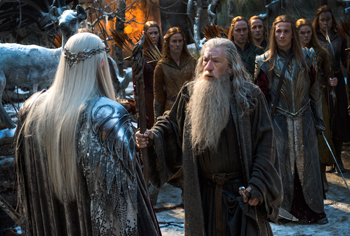 There And Back Again: The Story And Characters
There And Back Again: The Story And Characters An Ancient Enemy Rises
'The Hobbit" Trilogy's expansive ensemble cast includes a core of artists reprising their now-iconic roles from 'The Lord of the Rings" Trilogy. 'Now that a decade has passed since we made the first films, the iconography of the characters is everywhere," Peter Jackson notes. 'When Ian McKellen walked out on set, it felt like you were seeing Gandalf again"the line between actor and character has become so thin."
Holding a consistent place as a driving force and vital constant throughout both trilogies is the Wizard Gandalf the Grey, as embodied by Ian McKellen. From the moment Ian McKellen first donned Gandalf's Wizard's hat, the acclaimed stage and screen star has become the face of the Grey Wizard for generations of fans.
'Making these films has been a huge part of my life because of the distance I've traveled, the friends I've made, and this beautiful piece of storytelling that I've been lucky enough to be a part of," says the legendary actor. 'It's been lovely to have people come up to me and tell me what Gandalf means to them, and now I'm hearing from kids who were not yet born when we made the -Rings' films, who can't wait to see the last -Hobbit' movie. You just have to accept that Gandalf exists so strongly beyond the books and the films; he is an idea as much as person."
But the wise, compassionate and occasionally mischievous Grey Wizard is not invulnerable. Venturing alone to confront the re-emerged specter of Sauron"the ancient evil his fellow guardians of Middle-earth could not be moved to acknowledge"Gandalf has fallen directly into the Dark Lord's trap and faces certain death within the catacombs of the ruined fortress of Dol Guldur. But Gandalf will not face the Ancient Enemy alone. His ageless friend and powerful ally in the White Council, the Elf Queen Galadriel, once again played by Cate Blanchett, promised that if he needed her help, she would come. 'Gandalf is at his darkest ebb, really, when in comes the mighty Queen of the Elves," says Ian McKellen. 'This is one of Cate's more ethereal performances, but she's so good at being absolutely real. Galadriel and Gandalf clearly like each other enormously, and that reflects how much I like Cate Blanchett."
The acclaimed actress, who embodies the luminous Lady of Lothlorien across both trilogies, observes that the connection between Galadriel and Gandalf is among the strongest and most poignant in Middle-earth. 'What makes Gandalf such a wonderful mythic hero is that to save the world, he will move into the darkness that no one else is prepared to see because the stakes are so high for all of them," Cate Blanchett observes. 'Galadriel too will use all her powers to ensure that evil can't prevail, but she goes to Dol Guldur, knowing she may not emerge, out of her love for him. Every character in his film, including Galadriel, is put to the test in some way"not only against forces of evil, but often against themselves."
The stand-off ultimately draws the mighty Elvenking Elrond, played by 'The Lord of the Rings" Trilogy alum Hugo Weaving, along with the powerful Wizard Saruman the White, played by cinema icon Christopher Lee. 'Cate Blanchett and Hugo Weaving stepped right back into their iconic roles and are riveting as they bring all their characters' power and presence to these scenes," raves Philippa Boyens. 'And Christopher Lee, who has such an extraordinary sense of J.R.R. Tolkien, took delight in portraying Saruman at the precipice of the much darker journey he takes in -The Lord of the Rings' Trilogy."
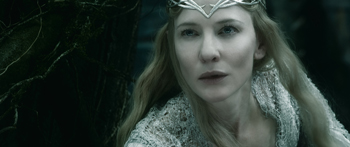 But the White Council's intervention may come too late. Sauron has already set in motion a campaign to enshroud all of Middle-earth in his own dark dominion. Glimpsed at the close of the second film, the Ancient Enemy fully emerges in the finale, played by Benedict Cumberbatch in his second role in the Trilogy.
But the White Council's intervention may come too late. Sauron has already set in motion a campaign to enshroud all of Middle-earth in his own dark dominion. Glimpsed at the close of the second film, the Ancient Enemy fully emerges in the finale, played by Benedict Cumberbatch in his second role in the Trilogy. Fran Walsh notes that upon Benedict Cumberbatch's first reading, the actor impressed the filmmakers with his commitment to bringing his dual roles of Sauron and the Dragon Smaug fully to life. 'Benedict Cumberbatch read for both parts, and was fantastic," she recalls. 'He ascribed completely different voices to these two characters and they don't sound at all alike."
Benedict Cumberbatch describes Sauron as less corporeal, but more evil. 'Sauron is between two states"neither a complete physical entity nor a purely spiritual one," the actor describes. 'Even in this state, he has great power, but it's a corrupt power"a complete absence of good. He's an incredibly destructive, selfish and brutally motivated force of evil and will stop at nothing to take over the world."
The Dark Lord is even now marshalling his Legion of brutal Orcs, led by the Pale Orc Azog the Defiler, again embodied by Manu Bennett, and his spawn, Bolg, played by John Tui, to stake his claim over the Lonely Mountain. 'In the novel, when the Orcs march toward Erebor, their origin is somewhat of a mystery," notes Philippa Boyens. 'But when you go back to the text, you come to understand that they appear in the wastelands in a very specific way. The truth is that the Erebor holds an incredibly strong strategic position that would leave all the lands beyond it open to attack. So, there's a much greater threat afoot than the people of Middle-earth know."
Woven into Sauron's scheme is an even more powerful weapon than Orcs"the Dragon himself. Benedict Cumberbatch offers, 'Smaug has a reputation as terrifying and stark as the reality of the scorched land all around the Lonely Mountain. He's a feared and powerful presence in Middle-earth. Who wouldn't want Smaug as an ally?"
But Smaug's centuries of slumber in his gilded den beneath the Lonely Mountain have come to an end, marking a dramatic shift in the order of Middle-earth…
A King Falls
'You are changed, Thorin. Is this treasure worth more than your honor?" "Bilbo
Martin Freeman, 'The Hobbit" Trilogy's inimitable Bilbo Baggins, comments, 'Bilbo's relationship with Thorin started out very rocky, but has thawed to become quite cordial, so, for him, to see what's happening to Thorin is like losing a close friend. Thorin has become consumed with this all-encompassing greed and fear"fear of losing anything, fear of giving anything away; he has to keep the treasure close at all costs."
As Bilbo faces a deeper test than any since he left Bag End, Peter Jackson notes that the actor continues to bring new emotional dimensions to his embodiment of the Hobbit. 'Martin Freeman always has a truth to him. He really gets under the skin of this character, and what he delivers is a very honest performance. For us, there was never any other choice for Bilbo Baggins. As you watch these films, you see that he's managed to build a character that is something iconic, but also very real."
Richard Armitage, who has essayed the fierce, brave and loyal Dwarf Warrior determined to restore the lost Dwarf Kingdom of Erebor, observes that what should be the end of Thorin's journey is actually the beginning of a much darker, internal one. 'In some ways, reclaiming the great wealth of his people brings Thorin back to life and ignites the great King that he has the potential to be," the actor notes. 'But it exacts a heavy price"greed, paranoia, the alienation of his friends. As soon as his skin comes in contact with that particular gold, it seeps into his soul and poisons him."
Fran Walsh notes that despite the efforts of Bilbo and his loyal Dwarves to help Thorin, the battle for his soul is one he must fight alone. 'Thorin is an extremely noble and flawed character, but his story is a tragic one, and very moving," says Fran Walsh. 'He is not someone you can judge for the decisions he makes. What he's fought for has become the most important thing, but it has turned on him, and he now stands to once again lose that great dream."
Dragon-sickness is named for the creatures that cannot resist gold, but has an equally corrosive effect on the Dwarves who hoard it. 'Thorin had looked into his grandfather's eyes and seen the madness of Dragon-sickness firsthand," Richard Armitage says. 'But he has suppressed the fear it provoked in him so deeply that he can't see what is happening to him even as it slowly consumes him."
Though fractured, Thorin's loyal Company of Dwarves, including Balin (Ken Stott), Dwalin (Graham McTavish), Fili (Dean O'Gorman), Kili (Aidan Turner), Bofur (James Nesbitt), Bombur (Stephen Hunter), Bifur (William Kircher), Oin (John Callen), Gloin (Peter Hambleton), Dori (Mark Hadlow), Nori (Jed Brophy) and Ori (Adam Brown), remain steadfast in their support of their King. But as the Dragon-sickness takes hold of him, Thorin narrows his trust to the one most responsible for expelling Smaug in the first place, even as Bilbo realizes that in securing the gold, he may have doomed his friend.
The Hobbit's bravery has yet more dire consequences as the vengeful Dragon is set loose outside the walls of Erebor.
A Dragon Unleashed
'Who are you that would stand against me?" "Smaug
Descending on Lake-town on his massive wings, Smaug assaults the crumbling wooden city at the foot of the Mountain with devastating force. In an awe-inspiring show of his power, the Dragon unleashes a torrent of rage upon the defenseless men, women and children of Lake-town, setting its homes alight with his fiery breath and leveling entire streets with the sweep of his tail. Benedict Cumberbatch likens Smaug's rampage to 'a child having a tantrum, but on a genocidal scale, and it's kind of unstoppable. But Smaug's fury is also his weakness. This Dragon is basically showing off. He wants to reinstate the fear that has kept him unchallenged all these years."
But, as powerful and crafty as he is, Smaug may have miscalculated the strength of Men. Luke Evans reprises his role as Bard the Bowman, whose lineage traces back to the last Man to fire a bow at the Dragon: Girion, Lord of Dale. 'Luke Evans has brought an enigmatic quality, but in this film, you get to see him step up to the role of hero," says Peter Jackson. 'Bard has hidden his lineage from even his own children, which goes back to the tragedy that occurred in Dale, the home of Bard's ancestors. He is also the only true bowman left in Lake-town. So, in a way, Bard is destined to meet this Dragon eye-to-eye."
For the widowed father of three children"daughters Sigrid and Tilda, played by sisters Peggy and Mary Nesbitt (daughters of the film's Bofur, James Nesbitt), and son Bain, played by John Bell"there seems to be no other choice. Of the humble bargeman with a powerful gift, Luke Evans says, 'From the outset, Bard's main objective is to look after his kids, and his family remains his primary focus throughout the whole journey in this film. It's a very pure thing that he's fighting for. He doesn't race into the Dragon's path for any kind of kind of glory. He knows he probably won't make it out of this burning husk of a town, but if he's going to die, he's determined to take Smaug with him for his children and the people of Lake-town. For him, this confrontation has become very personal."
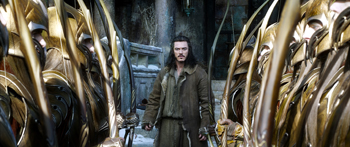 With the Master of Lake-town and his henchman Alfrid"once again played by Stephen Fry and Ryan Gage, respectively"either missing or hiding, it falls on Bard to lead the ragged survivors of Smaug's attack to Dale"a once-great city left charred and ruined by the same Dragon centuries ago. 'He has never been to Dale, only heard about it through stories, and what they find there is nothing but carnage and wreckage," Luke Evans says. 'But he has not forgotten Thorin's promise to repay his debt in helping the Company on their Quest, and hopes to use his share of the treasure to reignite the fires of Dale, and help the Lake-towners rebuild their lives."
With the Master of Lake-town and his henchman Alfrid"once again played by Stephen Fry and Ryan Gage, respectively"either missing or hiding, it falls on Bard to lead the ragged survivors of Smaug's attack to Dale"a once-great city left charred and ruined by the same Dragon centuries ago. 'He has never been to Dale, only heard about it through stories, and what they find there is nothing but carnage and wreckage," Luke Evans says. 'But he has not forgotten Thorin's promise to repay his debt in helping the Company on their Quest, and hopes to use his share of the treasure to reignite the fires of Dale, and help the Lake-towners rebuild their lives." But Bard is not the only one with a claim to the vast treasure under the Mountain. The Elvenking Thranduil, once again embodied by Lee Pace, emerges from the isolation of his Woodland Realm after receiving news of Thorin's feat.
Astride his great Elk, Thranduil leads his army of Elves into Dale for its strategic position relative to Erebor. 'Thranduil is aware of the events at Dol Guldur and knows Sauron's forces are already on the march," Peter Jackson notes. 'But he has not come to Dale to involve the Wood-elves in any greater fight for Middle-earth. He's following his own agenda. Something was promised to him before Smaug took Erebor from the Dwarves, and he has been waiting with infinite patience to collect." Lee Pace adds, 'There's something in the Mountain that is precious to him, and he'll get his hands on it one way or another. He will risk the lives of these Dwarves, and the Men of Lake-town, even his own people. As far as Thranduil is concerned, his engagement ends after he's claimed what's his. He's a complicated character"infinitely wise, but there's a wickedness about him, too." Thranduil has shown the iciness of his rule by banishing Tauriel, the Captain of his Guard, for the rebellious act of helping the Company of Dwarves on their Quest, but he is also aware that she has fallen impossibly in love with a Dwarf"Kili. 'Thranduil himself lost his great love"his wife"and has been through what Tauriel's experiencing when she chooses to fight for Kili," says Lee Pace. 'He is an incredibly tough character and seemingly very cold, but for all his complexity, you begin to understand who he is in this film, and it's quite surprising."
Evangeline Lilly, reprising her role as the fierce Tauriel, notes that losing her home and King has a profound effect on the character. 'Thranduil believed in her and gave her a special place in the Elven Guard," she says. 'So the fact that she betrays him, which Elves absolutely do not do, is very serious. Thranduil has been alive for thousands of years and has faced Dragons and fought historic battles, but Tauriel starts this journey as a very young and naïve Elf, and she sees a beautiful spark of life in Kili. She's incredibly strong, and very fortified emotionally, but she is also vulnerable. And this quest of hers ultimately leads her into an epic battle of her own, which will leave her forever changed."
The rift also has a profound effect on Legolas, Thranduil's only son. Orlando Bloom, who has embodied the iconic Elf across both trilogies, notes that these events set off the character's transformation as he faces a difficult choice between duty and a growing passion to engage in the larger Middle-earth. 'There is a fascinating dynamic between Thranduil, Legolas and Tauriel," Orlando Bloom says. 'Legolas has deep feelings for Tauriel, and will fight for her to the end, but his father is everything to him. This is a turning point in his life, which gave me an incredible opportunity to explore different emotional aspects of the character. What he does in this film really informs who Legolas becomes who goes on to be the lone Elf to join the Fellowship of the Ring."
Thranduil and Bard, each with his own agenda, move on Erebor together, but find themselves face-to-face with a very changed Thorin. 'Thorin himself is behaving very much like the Dragon now," says Richard Armitage. 'He will not even negotiate with the Elvenking. From his perspective, the Elves stood by and did nothing when the Dragon decimated his people long ago. He doesn't care if they bring the full weight of their armies; they're not taking a single piece of gold."
The loyal Dwarves, particularly Thorin's nephews Fili and Kili, watch aghast as their uncle refuses to honor his word not only to Thranduil but to Bard and the people of Lake-town, whose sacrifice they witnessed firsthand. The Company of Dwarves, while remaining fiercely loyal to their King, fear they lack the numbers to hold back an invading force.
What none of them knows is that Thorin has sent word to his cousin, Dwarf General Dain Ironfoot, played by Billy Connolly, whose Dwarven army will descend from the Iron Hills to defend Erebor from any onslaught by Elves and Men. Rather than trying to stave off war, Thorin is willing to sacrifice as many Dwarves as it takes to ensure the treasure stays where it belongs. Only Bilbo sees the growing danger, not just to the Company, but to Thorin himself. He continues to have faith that beneath the mask of corruption and greed, a kind and decent heart still burns within his friend. 'Bilbo knows there's no glory in either killing or dying in violence," Freeman comments. 'He would never have the appetite for war that the Dwarves have, particularly Thorin once the sickness of greed gets in him. At this point, he's not interested in collecting his 1/14th share of the treasure"he wants to avoid war at all costs. So he's going to slip away, not out of cowardice, but to find a way to avoid this massive, apocalyptic battle"
Five Great Armies Go To War
'You have but one question to answer: How shall this day end?" "Gandalf
The standoff over treasure, honor and fairness compounds with the greater threat of Sauron's plan to enshroud all of Middle-earth in Darkness. Gandalf has managed to escape near-death at Dol Guldur with the help of the Wizard Radagast the Brown, again played by Sylvester McCoy. Riding to Dale, he hopes to rally the armies of Elves, Dwarves and Men to stand together against this evil or risk losing everything they love, but the flames of war have already been lit. 'There are many strands to Gandalf's story, and he becomes very involved in the Battle of the Five Armies," says Ian McKellen.
'He believes the future of Middle-earth is at stake, so, for him, the stakes have gotten incredibly high."
Orcs are even now spilling into the slopes of Erebor from the Misty Mountains and Gundabad to the North, and Dale itself soon comes under siege. 'J.R.R. Tolkien described the battle in its strategic terms quite well, and we're following his blueprint," says Peter Jackson. 'Dale is a strategic location relative to Erebor, so whoever controls Dale will control the battle, and the fighting gets quite fierce in the city."
Bard enlists every Man in Dale to take up weapons against the Orc horde tearing through the city. 'Bard is not a man you would think could be able to lead an army," says Luke Evans. 'He's vulnerable and has never been in a position to fight so fiercely, but he steps up to defend his children and his people against these dark, wicked forces." Charging down the hillside into Erebor on the backs of giant boars, Dain Ironfoot and his Dwarven army collide with the Elven forces and their formidable King. 'Thranduil has led armies in the great battles of Middle-earth and survived," says Lee Pace. 'He's been swinging that sword for thousands of years and doesn't want to do it anymore. So, it's an interesting moment when he actually lifts it again because he's a force to be reckoned with."
Tauriel, likewise, does not hesitate to throw herself into the fray, but races to another front in the growing war in hopes of defending Kili from the Orc Legions. 'At her essence, slaying Orcs is what she lives for," says Evangeline Lilly.
She has equally lethal ally in Legolas, who takes on the deadly Bolg in a brutal, pulse-pounding stand-off. 'Legolas sees some pretty epic combat, and Peter Jackson has built in these brilliant action moments"like hanging upside down from a giant Bat," Orlando Bloom supplies. 'I love this character, and loved playing him to his full potential in this film."
As great creatures of Middle-earth swarm the skies and shake the ground from Dale to the slopes of Erebor to the Dwarven outpost of Ravenhill, the Battle of the Five Armies ignites. 'This battle has a different feel from those we've done in the past," Peter Jackson states. 'The different forces, the creatures, the vast fields of battle give it an overwhelming and terrifying scope. We are very much in the trenches with these characters as the war rages on multiple fronts."
Philippa Boyens notes that Peter Jackson himself became like a general to orchestrate all the movements in this protracted and brutal war. 'He really let his imagination run wild in staging this battle. But one of the things that he does understand is that you don't really care about the action unless you care about the characters caught up in it. So, for us, it was about finding those moments and making them feel real and truthful."
Even the Hobbit, in an effort to negotiate peace, finds himself drawn, unwittingly, into the Battle of the Five Armies. 'I think Bilbo's still shaky, but, miraculously, he has learned how to defend himself," Martin Freeman says. 'And this is an epic battle, involving hundreds of thousands of combatants, but the fun bit for me is when you see the human or Hobbit moments within all his fighting. Peter presents war as something that is terrible and tragic. You see the actual human cost of this war and what each of them is fighting for."
'It's really the high point of the entire journey for all of the characters, as all the chess pieces that have been set up on the board begin to move," says Richard Armitage. 'All the characters come to the battlefield, and there is a huge amount of action, great heroism and great tragedy as well. Thorin experiences his lowest point and his highest point in this film, and it was profound and exhilarating to take this role to such extremes."
Battle Plans: The Creation Of The Theaters Of War
You started this, Mithrandir. You will forgive me if I finish it. "Thranduil
'The Hobbit" Trilogy was shot concurrently over a 266-day initial block of production, with cast and crew reuniting for 10 weeks of pickup shooting to augment 'The Hobbit: The Battle of the Five Armies," with additional shooting on the performance capture stage. Throughout production, the company of artists and technical crew utilized all eight acres, including six soundstages, of Stone Street Studios on the Miramar Peninsula, and traveled across New Zealand"now known around the world as the cinematic Middle-earth"to bring the legendary battle at the center of the film to vibrant life.
'I have to say I cannot imagine making these films anywhere but this country," says native New Zealander Philippa Boyens. 'It's not just the incredible landscapes; it has to do with the way in which every-day Kiwis have embraced these films as part of their own. You have the sense that everyone here is cheering you on, and there is a depth of skill amongst the great artists and craftsmen who built these incredible sets."
The final film represented the last leg of Peter Jackson's filmmaking journey with his acclaimed band of behind-the-scenes collaborators, including director of photography Andrew Lesnie, production designer Dan Hennah, composer Howard Shore, make-up and hair designer Peter Swords King, Weta Workshop's Richard Taylor and Weta Digital's Joe Letteri, all of whom won Oscars® for their work on 'The Lord of the Rings" Trilogy, as well as costume designers Ann Maskrey and Bob Buck, and editor Jabez Olssen, who when not working side-by-side with the director on a stage packed up his editing gear to continue the process on the road.
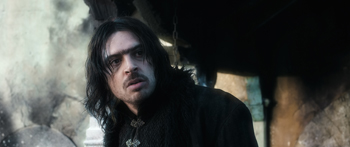 Dan Hennah, who was also nominated for an Oscar for his work on 'The Hobbit: An Unexpected Journey," along with supervising art director / set decorator Simon Bright and set decorator Ra Vincent, was charged with leading the effort to design and build the physical world of the Trilogy in exquisite detail, with an emphasis on the realistic and tactile. As with 'The Lord of the Rings" Trilogy, Peter Jackson also tapped the boundless creativity of renowned Tolkien illustrators John Howe and Alan Lee, who have throughout their celebrated careers developed an unparalleled feel for the aesthetic and emotional dimensions of the creatures, cultures and landscapes of Middle-earth. Cinematographer Andrew Lesnie adds that in addition to the design, John Howe and Alan Lee also provided a strong source of inspiration in capturing this world on camera. 'Their work excites the imagination and gave me a strong environment in which to imagine the story. I frequently showed Alan Lee and John Howe's work to the crew as a way of explaining the -feel' of a location or a sequence. It was always nice to pull off a shot that felt faithful to the tone of their work."
Dan Hennah, who was also nominated for an Oscar for his work on 'The Hobbit: An Unexpected Journey," along with supervising art director / set decorator Simon Bright and set decorator Ra Vincent, was charged with leading the effort to design and build the physical world of the Trilogy in exquisite detail, with an emphasis on the realistic and tactile. As with 'The Lord of the Rings" Trilogy, Peter Jackson also tapped the boundless creativity of renowned Tolkien illustrators John Howe and Alan Lee, who have throughout their celebrated careers developed an unparalleled feel for the aesthetic and emotional dimensions of the creatures, cultures and landscapes of Middle-earth. Cinematographer Andrew Lesnie adds that in addition to the design, John Howe and Alan Lee also provided a strong source of inspiration in capturing this world on camera. 'Their work excites the imagination and gave me a strong environment in which to imagine the story. I frequently showed Alan Lee and John Howe's work to the crew as a way of explaining the -feel' of a location or a sequence. It was always nice to pull off a shot that felt faithful to the tone of their work." From John Howe and Alan Lee's thousands of illustrations to Dan Hennah's detailed designs and finished sets, to the imagery captured in 3D at 48 frames-per-second on state-of-the-art Red Epic digital cameras, to the expansive visions of Weta Digital, the film's Middle-earth emerged as a multi-faceted and immersive environment that is itself among the Trilogy's most evocative and memorable characters. Within the sprawling art department at Stone Street Studios, Dan Hennah's team created a virtual miniature of Middle-earth in the form of 94 models for the entire Trilogy, built in multiples of 1:16 or 1:25 scale, before being transformed into exquisitely detailed life-sized sets for the film's alternately intimate moments and immense set pieces. For 'The Hobbit: The Battle of the Five Armies," Hennah and his team of roughly 350 people were tasked with transforming a number of existing sets while also hatching new vistas introduced in the third film.
One that is further explored in 'The Hobbit: The Battle of the Five Armies" is the ruined fortress of Dol Guldur, where Gandalf and the White Council at last face the Ancient Enemy Sauron and his dark minions. The abandoned castle at the Southern end of Mirkwood Forest was the site of the Dark Lord's defeat at the hands of the Elves, and where he re-emerges in 'The Hobbit" Trilogy to plot his return. Here, under the guise of the Necromancer, the Dark Lord has conjured the nine dead Kings"or Ringwraiths"whom the powerful yet vaporous entity has bound in servitude through his Rings of Power.
The ruined fortress was not described in detail in The Hobbit, but John Howe and Alan Lee visualised its tortured dimensions by drawing inspiration from its history as described in the appendices of The Lord of the Rings. The design emerged on the basis of an equilateral triangle"with three sides, three bays and three staircases on each interlinked facet"providing nine chambers for the Ringwraiths. 'The place is always a kind of reflection of the character of the people that that live there, so we knew it had to be very creepy, redolent of evil and the horrible, gruesome things that happen there," Alan Lee details. 'Sometimes not having a strong idea in mind allows the design aesthetic to grow, and Peter Jackson really liked the tall, twisted shapes we landed on."
In all, Dan Hennah oversaw the design and construction of six sets riven through with age and rot within its stone structure and rusted metal strapping. 'This is an environment in which you immediately feel the evil that has collected there," Dan Hennah describes. 'There are skeletal remains, and everywhere you look are metal spikes, chains, and great, thorny vines"all of which immediately evokes a sense that something bad has been taking place here. It runs down a hillside through treacherous, winding staircases, and all of the lower levels have been degraded either by the battle that took place here or by natural erosion over the decades. There's nothing comfortable about this place."
Andrew Lesnie made full use of the angles created by the three-sided structure and gloomy mise-en-scène. 'Andrew Lesnie's work is heavenly," raves Cate Blanchett, whose character undergoes a dramatic transformation in this environment. 'So, that part of the work is done for you. Yet sometimes it's important to then make the scene a counterpoint to the atmosphere."
Descending barefoot into this crucible of corrupted power, Galadriel appears to transcend its rotted stone in her white, flowing gown. For Ann Maskrey, who designed the film's costumes along with Bob Buck and Richard Taylor, the challenge was to create a costume that would be appropriately ethereal, but grounded in contrast with her dark yet fiery opponent. 'It's not difficult to dress Cate because she moves beautifully," Ann Maskrey says. 'She has a certain way of walking on the balls of her feet or her tip-toes that makes it look like she's hovering gracefully, so the costume had to be as graceful as she is."
Drawing inspiration from a dress worn by legendary dancer Margot Fonteyn in the ballet 'Ondine," Ann Maskrey sourced a metallic lace from Cate Blanchett's native Australia, and dyed, stripped and re-dyed the fabric until it attained a translucent shimmer 'By then, we thought it was going to fall apart but, in fact, the weathering had a great effect," she says. 'It is the palest silvery blue over a slightly metal-gauge fabric, all cut on the bias." To complement the dress, Maskrey designed a silver brooch inset with moonstone.
The Kingdom Under The Mountain
To the East, beneath the Lonely Mountain, Thorin and the Company of Dwarves have staked their claim on the lost city of Erebor, portions of which were glimpsed in 'The Hobbit: The Desolation of Smaug." For the design team, Erebor was conceived as an expression of the personality and aesthetics of the Dwarves, and built in continuous segments within the cavernous soundstages at Stone Street Studios.
Because the Dwarves mined precious gems throughout their centuries within the Mountain, its caverns follow the veins of green marble, rendering them asymmetrical and random. Notes Alan Lee, 'Erebor is a fine underground labyrinth, essentially, designed to feel like a kind of paradise for the Dwarves. Everything is very geometric, crystalline and faceted, with lots of plunging depths and massive statuary of gold."
Having initially developed a map of Erebor, Hennah wanted to establish at once the enormous scale of the Kingdom and also suggest that within it were living quarters with kitchens and bedrooms, in addition to a counting lair where they count their diamonds. With Smaug no longer stalking its halls, the Company of Dwarves are free to explore and ultimately uncover the hidden armory"what Dan Hennah calls the 'beating heart of the Mountain""containing the weapons and armor of their ancestors. 'It's not the great Erebor treasure, but it's the treasure of the warriors. It's quite intimate for them, but powerful at the same time."
Here, the Dwarves don their regal full-plate armor and emerge resplendent on the ramparts of the Lonely Mountain, fully prepared to defend it. The armor was created by Weta Workshop with fabric 'clothing" elements designed by Bob Buck and the costume team. "We worked with Weta Workshop by breaking down their designs and realszing what would be worn underneath the armor," notes Bob Buck. 'It became apparent that they would not, in fact, fight in the full armor, but strip down to a more practical -street fighting' look to face their enemy in hand-to-hand combat, and that it could be a fight to the death. The focus was on maintaining and highlighting the characters' individuality and celebrating the richness and master craftsmanship of Erebor, while also reinstating the color palettes we've already established in their travel clothes, and honoring the fighting style of the Dwarves."
The armor was created in collaboration between the costume design team and Weta Workshop. 'We worked with Weta Workshop by breaking down their drawings and making samples for fittings," notes Bob Buck. 'The focus was on maintaining individuality, following the color palettes we've already established for each character, and honoring the fighting style of the Dwarves."
The costume design team envisioned Thorin's armor in black and gold, with a raven theme that ties to references Tolkien made to the Dwarves' alliance with ravens, which act as their messengers. Once worn by his grandfather Thrór"the last Dwarf to succumb to Dragon-sickness"the armor seems to complete the effect on Thorin. 'He has the crown on his head and his father's fur mantle, so he's completely enrobed in this gold that's slowly consuming him," says Richard Armitage of his character. 'He almost becomes the gold."
Thorin's stripped-down armor look consists of a Dwarven leather jacket made from woven leather lattice much like a cage, with geometric boarders and the raven emblem stamped into the yoke. 'We wanted to keep him kingly, but also to be tough and grounded," Bob Buck comments. 'The leather lattice plays with the metaphor of Thorin being trapped in his sickness for gold."
Another family line Bob Buck traced in the designs is armor worn by Gloin, played in the film by Peter Hambleton, who appears on the ramparts in the helmet that will eventually be worn by his son, Gimli, portrayed by John Rhys-Davies in 'The Lord of the Rings" Trilogy.
Perhaps the most challenging armor to design was that which envelops the body prosthetic worn by Stephen Hunter to portray Bombur. His vast belly plate of armor was an undergarment, much like a brigandine, constructed using tessellations"repeating shapes that fit together like puzzle pieces to create a form.
In battle, Dwarves are formidable fighters and incredibly strong despite their relatively small stature. The actors utilized exaggerated fighting styles to register their moves onscreen when scaled down through digital techniques. To allow for more flexibility and comfort in fighting sequences, Bob Buck and his team created battle looks by referencing Byzantine, Medieval, Mongolian and Japanese culture, ultimately utilizing an array of velvets, leathers and suedes that were quilted, stamped and textured in the style of medieval brigandines and gambesons or Japanese kikko.
A diverse array of oversized weapons were created for the Dwarves at Weta Workshop, with Richard Taylor's team cross-referencing weapon prototypes with the finished armor and fighting style of each character. Once they achieved a finished silhouette, a batch of cardboard cutouts would be sent to the set, ranging in size from small to extra-large, for peter Jackson's final sign-off. 'More often than not, Peter Jackson would pick the largest," reports lead concept designer Nick Keller. 'The size became a problem when it came to scabbards. A large sword looked good but large scabbards could look clumsy, so we gave them more streamlined holsters."
Dale And Lake-Town In The Wake Of Smaug
The largest outdoor set created for the Trilogy was the 1,600-square-foot city of Dale, which Hennah and his team constructed atop Mount Crawford, overlooking the city of Wellington. The sprawling set took 200 carpenters and artisans over twelve weeks to build, with tradespeople using a wide range of methods"from medieval techniques to state-of-the-art laser cutting"to create 36 houses and battlements, including the King's Palace and Great Hall.
Glimpsed in the prologue of the first film, as Smaug descends upon the thriving cosmopolitan city on his way to the Lonely Mountain, Dale was designed and built to represent a 20 stylistic fusion of Eastern architecture, with Tibetan and Tuscan motifs and Eastern European stonework. John Howe recalls how he and Alan Lee imagined a place that would evoke a variety of existing world cities, 'from Tibet to Nepal to Northern Italy. When people would visit the set on Mount Crawford, it would remind everyone of a different place."
Described by J.R.R. Tolkien as the 'orchard city," Dale is colorful and abundant with foliage. 'It was full of various types of grapes and fruit trees," Dan Hennah describes. 'It felt very much like a Tuscan Village, but we deliberately infused it with a slightly Nepalese culture, in terms of our palette and the timber accents against the stonework. So, if you had a great big stone building, you'd have a window box or veranda made of wood that cantilevered off the stone, which was then painted in bright primary colors."
For 'The Hobbit: The Battle of the Five Armies," Dan Hennah had to then reimagine Dale as a ruin, left charred and abandoned following the Dragon's rampage more than a century earlier. The production designer tasked his team with tearing out the foliage, attacking the finely detailed buildings with chainsaws, burning the wood and aging the city. They then re-vegetated the set to create a sense of nature having taken over, with wandering trees and vines that, in places, overtook the architecture. 'The stone remains, but all the wood has been blasted away," he describes. 'It was beautiful before the fire, but I have to say, it had a real character to it after the fire."
Within the rubble of the decimated city are scattered remnants of clothing, ceramics, blankets, weapons, even the mummified remains of the fallen. 'Our idea was that by some unknown chemical process, the people have been virtually mummified by the hot gas of Smaug's breath, resulting in a somewhat ceramic effect," Dan Hennah describes.
After razing, breaking and dressing the city, the art department then imbued Dale with the grim, cold feel of Middle-earth in the heart of winter. The landscape was blanketed with snow created using a Dacron base and biodegradable agricultural products for the powder. A paint technique with a resin finish was used to render surfaces icy and slick. The resulting environment was bleak, stark and permeated with fog.
Upon Thranduil's arrival with his army, the Elvenking sets up a base of operations within a giant tent erected inside Dale's Great Hall, which he's furnished with finely crafted chairs, pelts, candle-sticks and platters. 'It creates contrast when you see the comfort and elegance of Thranduil's tent and out through the door is the wreck of this beautiful Hall," Dan Hennah notes. 'It's almost like a cathedral that's been wrecked on the inside. He can see the entire battle and the gates of Erebor from that spot."
The crumbling, wooden city of Lake-town is likewise torched by Smaug in a devastating rain of fire that unfolds in real time in 'The Hobbit: The Battle of the Five Armies." Dan Hennah had built a practical version of Lake-town across two sprawling sets, one on the Stone Street backlot, which spanned 25,000 square feet, and another on its K Stage, which spanned nearly 13,000 square feet at its apex.
Fortunately, Weta Digital had digitally recreated each of the set's buildings and added many more to extend it to its full 2.2 million-square-foot span, so Jackson was able to orchestrate Smaug's rampage without having to reduce Dan Hennah's exquisite set to cinders. 'We built Lake-town for -The Desolation of Smaug' and see it utterly destroyed in -The Battle of the Five Armies,'" notes senior visual effects supervisor Joe Letteri.
The visual effects team created four digital versions of each Lake-town building as it undergoes escalating levels of destruction. In some cases, the virtual Lake-town saw fire simulations consuming entire blocks, while the Dragon's fiery breath blasted the surface of the lake into vapor. Notes visual effects supervisor R. Christopher White, 'We developed software for this film that allowed us to create different types of fire depending on what material was burning. The fire needed to be realistic and keep to the laws of physics, but it also needed to meet Peter's aesthetic requirements."
Each digital element was designed to realistically react to external forces, including how each building would collapse or disintegrate under the weight of Smaug's body or great, sweeping tail. In total, the digital model contained nearly 1,500 finished structures.
The destruction sequences at Lake-town were so complex that Weta Digital needed to innovate to find faster, more efficient ways to render them, which resulted in a new workflow that leveraged their pioneering deep-composting tools. Within the compositing package, fully realistic volumetric fires from the effects department could be easily manipulated, placed and rendered in 3D. This inventive technique ultimately brought a whole new level of detail to the 300 effects shots within the Lake-town sequence.
The Fields Of Battle
The history of Middle-earth is scored with massive battles, but one of the largest and most spectacular within the J.R.R. Tolkien canon is The Hobbit's Battle of the Five Armies, which ignited the imaginations of every creative team involved in bringing it to life.
Before production even began, the creative staffs of Weta Workshop, Weta Digital and Dan Hennah's art department had all brainstormed independently to map out this enormous event. Their separate collaborations were ultimately fused throughout production as Jackson called representatives from all creative teams into sweeping 'think tank" meetings to inspire each other and harmonize the practical and digital elements of the final battle for Middle-earth that Peter Jackson is bringing to the screen.
A decade earlier, Peter Jackson originated the 'rush and clash" of massive armies meeting on the battlefield"an aesthetic that has since been emulated by countless films. For the epic centerpiece of 'The Hobbit: The Battle of the Five Armies," the filmmaker envisioned a sea of spears reminiscent of art depicting the Napoleonic war, but with a clear line of action from beginning to end. 'Peter Jackson was intensely concentrated on orchestrating something that people could follow from beginning to the end," says conceptual artist John Howe. 'He didn't want it just be a mass of people whacking their swords together. The locations and legible troop formations helped put structure into it, as did fluctuations in the intensity of the fighting."
Great armies of Elves, Dwarves and Men clash on the slopes of Erebor, joined by swarms of menacing Orcs that also spill into Dale and the mountain outpost of Ravenhill"all punctuated by hordes of exotic creatures that thunder across the lands and darken the skies.
With so many and such varied forces in play, it was critical that the armies could be perceived separately from a distance, as well as the allegiances of each mass of fighters. For the world-renowned physical effects house Weta Workshop, under the direction of creative director and co-founder Richard Taylor, the challenge was to create broad visual identities for each opposing force. 'Authenticity is crucial throughout the process," notes Richard Taylor. 'Nothing is created to just look good; there is a back-story to every weapon, shield or helmet. Hours were spent deliberating over what deserves to become a part of the Middle-earth legacy. We wanted every piece to look as if it was manufactured at the time of the story, with the incredible access to craftsmanship that existed at the time."
One new army that is introduced in the final film are the Iron Hill Dwarves, led by Dain Ironfoot, played by Billy Connolly. To festoon this proud, fierce tribe, Jackson wanted no curved surfaces, and Weta Workshop drew inspiration for their war look from the aesthetics of a boar" strong, sturdy and fierce. The boar became a motif for the Iron Hill Dwarves, imprinting their armor and weapons.
Dain himself rides a boar into battle, a digital creation rumored to be modeled after the New Zealand native Kuni Kuni pig. During production, Peter Jackson developed a soft spot for the breed and ultimately adopted the on-set Kuni Kuni pigs Picklet, Itchy and Scratchy. 'If you were a Dwarf, why wouldn't you want to ride on a pig?" Peter Jackson posits.
This digital beast of war is one among many. 'It's surprising how many digital characters and creatures we created for this film"not just the armies but trolls, ogres, worms, rams"the list is almost endless," reflects visual effects supervisor Eric Saindon. In fact, the Elvenking rides into battle astride a great Elk, chosen as a reflection of the character's stature, strength and elegance. Quick, deft and fluid, the Elves are among Middle-earth's most lethal warriors. Their tall and nimble aesthetic created something of a design challenge for Weta Workshop in creating battle-tough armor that would not compromise their elegant silhouette. Ultimately, their armor emerged as a warm silver bronze, with flowing skirts accentuated by leaf and forest forms that nearly touch the ground, enhancing their lithe grace.
For the weapons they carry, Weta Workshop developed blades with bronze or copper finishes. '-The Lord of the Rings' films is always our starting point," says concept artist Paul Tobin. 'But we pushed the Mirkwood Elves into the Bronze Age, older and wilder, with a more barbed and dangerous edge to their weapons." Adds Richard Taylor, 'You are making something for the most sophisticated and beautiful people of Middle-earth. These items reflect their craftsmanship, lineage and heritage."
Thranduil himself wears a singular armor that distinguishes the High Sindar Elf from his Silvan Elf army, and in fittings, actor Lee Pace put it through the motions to see how it would move in battle. 'Lee Pace didn't just stand there in a fitting"he went through all the moves he developed with the stunt department," notes Bob Buck.
Created in collaboration Weta Workshop, Thranduil's armor is cold chrome with accents of black and deep royal red. The velvet of his cape was designed to drape like liquid silver, an effect that helped blur the lines between metal and fabric, with panels detailed with decaying leaves. Laser-cut leather and devoré velvet were laminated together, gilded with silver and hand-stitched onto a strong net fabric to blend the line between the hard and soft elements of his costume. Notes concept artist Daniel Faloner, 'When he moves, you see flashes of color, and the contrasts show in his silhouette."
Thranduil's sword is constructed from a single piece of aluminum. 'It's an incredible sword," says Lee Pace. 'It's as long as my leg and has beautiful Elvish themes cut into it."
By contrast, the hordes of Orcs dispatched by Sauron are a large, misshapen breed created as an entirely new and heavily militarized design that departs from Orcs seen in previous films. Weta Workshop created 100 new individual Orcs, each with a distinct helmet and any number of unique accents, including pikes, pole arms, spears, swords, shields, teeth, contact lenses and distinct prosthetics. Orc chieftains Azog the Defiler and Bolg wear heavy armor in battle, with the Pale Orc wearing white armor infused with skull forms, including an eye socket theme on his pauldrons, with armor designed for his brutal spawn around a spine motif, grotesquely bolted into his bone structure. Both Azog and Bolg are fully CG characters created through the artful mix of performance capture performances by Manu Bennett and John Tui, respectively, and keyframe animation from Weta Digital's extraordinary animation team. 'Azog is a major presence in this film, and really shines as he takes his place among Gollum and Smaug as fully realised digital characters," says Joe Letteri. Weta Digital animator Dave Clayton compares Bolg to 'a horrible terminator psycho killer. Neither Bolg nor Azog attract attention as fantasy CG creations"their motivations and emotions are part of the fabric of the story."
The film's digital characters and environments alike were all achieved with compounded realism, speed and efficiency through Weta Digital's breakthrough rendering software Manuka. In creature creation and digital double work, Manuka represented a leap in imbuing the flesh of the digital characters through advancements in sub-surface scattering on the skin and the maturation of tissue. Visual effects art director / prosthetics supervisor Gino Acevedo notes that Jackson had a specific aesthetic in mind for Azog, wanting to blur the lines between his white metal armor and pale skin. 'Azog needed to look brutal, so the challenge with the armor was to make it look like hard metal, not like aluminum," Gino Acevedo says.
Using basic grey models built by the models department with Maya or Mudbox as a foundation, Acevedo and his team sourced a variety of textures from their extensive digital library, then painted and textured the models using the 3D painting program Mari. Once fully textured, the character can then move in a given shot, but often returns for tweaking based on how it reacts to different lighting environments.
Weta Digital also created a staggering array of clashing forces that move through each theater of battle. Beyond the roughly 5,000 Elves and Dwarves depicted in one sequence, they created up to 30,000 swarming Orcs in a single simulation, as well as the 6,000 Gundabad Orcs that follow Bolg South toward the Mountain. The battle also sees the emergence of giant, lumbering Trolls and Berserker Orcs, which are paler, more massive versions of those seen in 'The Lord of the Rings" Trilogy. 'Peter Jackson wanted the Berserkers to stand out on their own," explains Acevedo. The effects house delivered the giant Bats that descend on the battle, conceived by Acevedo and conceptual artist Alan Lee. Though massive, Acevedo wanted to infuse these creatures with as much realism as possible and took great pleasure in photographing and studying the giant fruit bats at the Wellington Zoo.
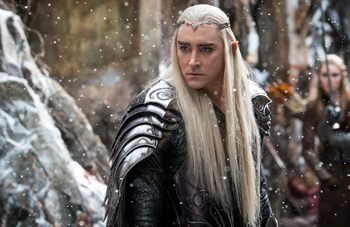 'A good portion of the battle is entirely digital"the armies, the creatures, the action and the fighting," notes visual effects supervisor Matt Aitken. 'Then there are the effects – fire, smoke, destruction. All of this had to be meticulously combined, detailed and refined to appear seamless and palpably real."
'A good portion of the battle is entirely digital"the armies, the creatures, the action and the fighting," notes visual effects supervisor Matt Aitken. 'Then there are the effects – fire, smoke, destruction. All of this had to be meticulously combined, detailed and refined to appear seamless and palpably real." Of the fighting environments created practically by Dan Hennah and produced whole or in part by Weta Digital"including bridges, frozen lakes and waterfalls, battlements and ramparts"the 'minimalist but strong" Ravenhill was his favorite. A fortified Dwarven outpost located at the Southern Spur of the Lonely Mountain, Ravenhill is the stark, dramatic set piece for a number of pivotal confrontations, from brutal hand-to-hand combat as opposing forces join together to hold back the tide of Sauron's campaign to the resolution of highly personal vendettas. Among these are Legolas's brutal clash with Bolg on a collapsing tower spanning an icy river, and Thorin's epic showdown with Azog the Defiler on the stark surface of a frozen lake.
The chaos and drama is enhanced by the chilling atmosphere that pervades that mountain lookout. Rather than utilize dry ice on set, Weta Digital infused the scene with a sinister and chilling fog that seeps through and across Ravenhill.
While the digital elements created the canvas, each sequence was brought to life through the performances and emotional content of the scene. 'Battle sequences, no matter how large always hinge on the detail," says Eric Saindon. 'Every clash needs to resonate; the audience needs to believe that something"everything"is at stake for these warriors."
Equally important in this effort was how each creature or character fights for what he or she believes in. The actors developed their expressive moves with movement choreographer Terry Notary, who also worked closely with the stunt team throughout preparation and production. The goal in each instance was to develop body language and movement styles that communicate the essential character of each player.
Martin Freeman describes the experience of taking Bilbo through his paces as 'unlike anything I've ever done, or anything I'm likely to do again," he reflects. 'It was very intensive and concentrated, and good, hard work"that hard work that we enjoy where you kind of feel like you've earned your glass of wine at the end of the night."
Notary's work also extended to the performance capture stage, where the fight choreography of 12 stunt performers fighting simultaneously in the volume would digitally multiply into the clash of thousands of forces on the battlefield.
For stunt coordinator Glenn Boswell, the performance capture technique, combined with 3D shooting, necessitated some adjustments in the choreography. 'The hits had to be as close to connection as possible to register as an impact digitally," he notes. 'But we had highly skilled performers on the stage, everyone is padded up, and, in some ways, it was safer for the stunt team than live action fights."
In somewhat of a visual effects reversal, Weta Digital sought to animate the sweeping battles early in the process to allow Jackson greater freedom in shaping them for the final film. Referencing existing footage of the landscapes, as well as concept sketches created by John Howe and Alan Lee, Weta Digital created a sprawling computer model of the entire region that is overtaken by war. 'We sculpted the world to accommodate the action," comments senior visual effects supervisor Joe Letteri. 'We could change the size of the army, or move mountains, rivers or cities on the fly, without being locked on a given location or having to tear down and reshape a set. In some cases, the battle exists exclusively in the computer, so live action footage was often integrated directly into our virtual world. It was a continuous process that allowed Peter the kind of freedom you can achieve with digital filmmaking."
The visual effects house then populated the landscapes with thousands of forces locked in battle using proprietary software they have innovated far beyond the Massive technology they developed for 'The Lord of the Rings" films to bring a whole new level of creation and control to 'The Hobbit: The Battle of the Five Armies." Notes Eric Saindon, 'We pushed our virtual stage technology to give Peter the maximum control over the individual components of each battle."
Walking through a motion capture stage, Peter Jackson was able to maneuver with the characters through a 3D landscape populated by thousands of combatants, and 'shoot" sequences with the virtual camera. Within each sequence, the filmmaker was able to make aesthetic choices, from framing and timing, to angles, camera movements and lens choices. Notes Genevieve Aitken, 'Rather than providing believable simulations for immense armies, we provided detailed animated combatants at an unprecedented scale. Peter Jackson could actually walk through each environment virtually, and create sequences that wouldn't be able to be committed to cinema any other way."
'It was wonderfully exciting to use the virtual camera like a cameraman in real space," Peter Jackson remarks. 'Through this technique, I was able to discover angles that I never could have imagined." Guided by Peter Jackson's direction, Weta Digital then fused the live action and digital elements into one cohesive, continuous sequence, representing the first time the effects house has used Manuka on a film as their primary renderer. Developed by Weta Digital, Manuka creates complex, detailed images quickly and efficiently. 'Manuka was designed for big projects where you need precise detail on an enormous scale, and we could not have done a film of this scope without it," says Joe Letteri.
The creation of the film's staggering 1,836 visual effects shots ultimately consumed what's called 16,000 render years, including various digital elements that enhance primarily live action sequences. 'The light interactions between the fog, the clouds, sky, water, ice, skin, hair"it all works together to make you feel like you are there," Joe Letteri describes.
The battle itself unfolds on screen in linked and escalating waves of combat. 'I wanted the battle footage to feel like it was shot by a combat cameraman," Peter Jackson reflects, 'like someone took a news camera into the middle of the Battle of the Five Armies, with the ultimate goal of plunging the audience directly into the trenches to feel the tension and energy of the visceral action playing out around them."
The Last Goodbye: The Final Mix
Everything I did I did for them. "Thorin
With 'The Hobbit: The Battle of the Five Armies," Peter Jackson's aspiration for total immersion continued on the mixing stage as he worked with supervising sound editors Brent Burge and Jason Canovas. From Smaug's fiery exhalations to aural expression of Galadriel's spectral light, the film's fully realised imagery has an aural dimension composed of shifting, multi-layered soundscapes. Whether recording ambiance on the set or capturing the utterances of native New Zealand birds or wild animals from around the world, sound designers David Farmer and Dave Whitehead created a visceral language of sounds that accompany each character, culture or great canvas of battle with breathtaking fidelity. 'The Middle-earth films are sonically rich and full, and don't support synthetic sounds," says David Farmer. 'You don't want to hear swords cleanly clanging together, you want to hear the dirt and gravel grinding or swords thudding on rocks."
'It's gritty and messy," adds Kris Whitehead, who captured a lion's roar during a family visit to the zoo that became the basis for sonic signature of the Wargs on whose backs the Orcs ride into battle. Whitehead then digitally manipulated and layered the roar to create 'something that doesn't exist in the natural world."
In the final mix, the sound team worked with Jackson to perfectly balance picture with dialog, sound effects, ambiance and, of course, the film's music. To provide what Peter Jackson calls 'the heartbeat of the film," the filmmaker once again enlisted the composer whom he affectionately calls 'the 16th member of this Company." 'Over the last 14 years, I have been lucky enough to spend many hours listening to, giving notes on and losing myself in Howard Shore's music of Middle-earth," the director reflects.
As on the previous 'Hobbit" film, Howard Shore composed the score for 'The Hobbit: The Battle of the Five Armies" from his Tuxedo, New York, home, while Jackson attended scoring sessions with renowned orchestrator Conrad Pope conducting the New Zealand Symphony Orchestra. Once again, the ideal environment for recording this critical component in the Middle-earth experience was the 100-year-old Wellington Town Hall, with legendary Abbey Road sound engineer Peter Cobbin and Kirsty Whalley overseeing the mix.
The composer's musical themes are infused with choral pieces recorded at Abbey Road and AIR Studios by London-based choral ensemble London Voices, under the direction of Terry Edwards and Ben Parry. But, perhaps more than any film in the Trilogy, Jackson and his collaborators wanted to say goodbye with an end title song that would express their complex emotions upon concluding their final journey.
In dreaming up what that could be, Fran Walsh recalled the memorable voice of actor Billy Boyd, who played the Hobbit Peregrin Took"or Pippin"in 'The Lord of the Rings" Trilogy. Not long after, Jackson, Walsh and Philippa Boyens enlisted Boyd's help to compose a worthy song to close out the Trilogy. The result of their collaboration is 'The Last Goodbye."
'I wanted the song to be a goodbye to all the fans who have been part of this amazing journey and to the whole world of Tolkien as it has been told in the cinema for our generation," Billy Boyd says. 'I felt incredibly touched and honored to be asked to write and perform this song, and to be at the start and end of these beautiful, historic stories."
'-The Last Goodbye,' as performed by Billy Boyd, is both a farewell to Middle-earth and also our leave-taking of the audience," says Peter Jackson. 'We cannot imagine a more perfect voice to carry us away from the shores of Middle-earth…one last time."
For Peter Jackson, Fran Walsh and Phillipa Boyens and their filmmaking team, for the actors who have spent years in Middle-earth and for those who have dwelled in it for more than a decade, the end of the journey marks an equally powerful moment. 'The most profound moments of closure, for me, were when we finished shooting with each of the actors on set," Peter Jackson remembers. 'It was intensely emotional because even though you're going to still be friends with these people, you're never going to see these characters on screen again."
Ian McKellen muses, 'I don't feel I've said goodbye to Gandalf because I'm constantly reminded by people who have enjoyed the films that Gandalf is alive and well, although where he is at the moment, I don't know. Up to mischief somewhere, no doubt," he smiles, adding, 'The weight that Peter Jackson has carried on these films is unimaginable to me, but even under all that pressure, I've never seen him indulge in a callous word toward anyone. Even though he's younger than I am, he has a slightly fatherly feeling for me"and I've always known that we were on the same journey and that he would see it through with grace. And he has."
'I'm hoping that for fans of this world, this film is completely fulfilling," Martin Freeman says. 'I also hope that people who aren't conversant with the story get taken on an amazing ride and it opens something for them that will lead them to read the books and see -The Lord of the Rings' films. There is such a scope to this. It's pretty big filmmaking. I think it's going to be genuinely thrilling, a bit scary, and, hopefully very moving."
'These movies are being made by the biggest fan of Tolkien that exists and the biggest fan of cinema," Richard Armitage adds. 'Everywhere I go, I hear how much people are looking forward to see this story through to the end. In this body of work, the circle is now complete."
Looking back on his 16 years exploring Middle-earth and the remarkable legacy he now leaves behind, Jackson concludes, 'For the first time since we began working on -The Hobbit' films nearly seven years ago, a sense of something coming to a close washes over me. Perhaps it is because, as Bilbo tells Gandalf, it is the last road. The opportunity to come back and tell the rest of the story has been a tremendous honor for all of us, but we now hand it off to the people for whom these films were made."
The Hobbit: The Battle of the Five Armies
Release Date: December 26th, 2014
Have You Seen This?
MORE
- Mission: Impossible Fallout
- Glenn Close The Wife
- Allison Chhorn Stanley's Mouth Interview
- Benicio Del Toro Sicario: Day of the Soldado
- Dame Judi Dench Tea With The Dames
- Sandra Bullock Ocean's 8
- Chris Pratt Jurassic World: Fallen Kingdom
- Claudia Sangiorgi Dalimore and Michelle Grace...
- Rachel McAdams Disobedience Interview
- Sebastián Lelio and Alessandro Nivola...
- Perri Cummings Trench Interview

